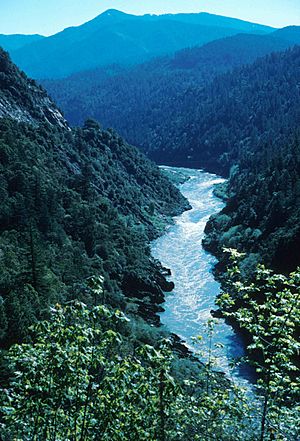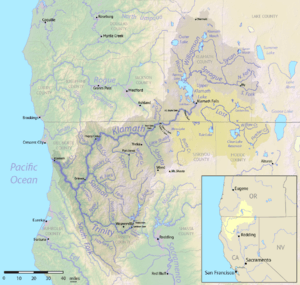Klamath River facts for kids
Quick facts for kids Klamath River |
|
|---|---|

The Klamath River in California
|
|

Map of the Klamath River watershed
|
|
| Native name | Ishkêesh |
| Other name(s) | Link River, Everglades of the West |
| Country | United States |
| State | Oregon, California |
| City | Klamath Falls |
| Physical characteristics | |
| Main source | Upper Klamath Lake Klamath Falls, Oregon 4,090 ft (1,250 m) 42°11′29″N 121°46′58″W / 42.19139°N 121.78278°W |
| River mouth | Pacific Ocean Requa, California 0 ft (0 m) 41°32′49″N 124°5′0″W / 41.54694°N 124.08333°W |
| Length | 257 mi (414 km) |
| Basin features | |
| Basin size | 15,689 sq mi (40,630 km2) |
| Type: | Wild, Scenic, Recreational |
The Klamath River flows 257 miles (414 km) through Oregon and northern California in the United States, emptying into the Pacific Ocean. The Klamath is the second largest river in California after the Sacramento River.
Unlike most rivers, the Klamath begins in the high desert and flows toward the mountains – carving its way through the rugged Cascade Range and Klamath Mountains before reaching the sea. The upper basin, today used for farming and ranching, once contained vast freshwater marshes that provided habitat for abundant wildlife, including millions of migratory birds. Most of the lower basin remains wild, with much of it designated wilderness. The Klamath has been called "a river upside down" by National Geographic magazine.
The Klamath is the most important North American river south of the Columbia River for anadromous fish migration. Its salmon, steelhead and rainbow trout have adapted to unusually high water temperatures and acidity levels relative to other rivers in the Pacific Northwest. The numerous fish were a major source of food for Native Americans, who have inhabited the basin for at least 7,000 years.
The first Europeans to enter the Klamath River basin were fur trappers for the Hudson's Bay Company in the 1820s; they established the Siskiyou Trail along the Klamath and Trinity rivers into the Sacramento Valley. Within several decades of white settlement, native peoples were forced into reservations.
During the days of the California Gold Rush, increasing numbers of miners began working the Klamath River and its tributaries, causing considerable harm to the environment. Conflict and introduced diseases left indigenous tribes with only 10% of their original population.
Steamboats operated briefly on the large lakes of the upper basin, contributing to the growth of towns such as Klamath Falls, Oregon, before they were replaced by railroads in the late 19th century.
In the 19th and 20th centuries, the upper basin became a productive agricultural region, and many dams were built to provide irrigation and hydroelectricity. In the 1960s, the Klamath River was targeted by much larger, but ultimately unsuccessful schemes to augment water supplies in other parts of California. One of these projects, the Klamath Diversion, would have reversed the entire flow of the Klamath River to supply farms and urban areas in central and southern California.
Today, the Klamath is a popular recreational river as well as an important source of water for agriculture. It includes many of the longest free-flowing stretches of river in California, including excellent stretches of whitewater. However, dams and diversions in the upper basin have often caused water quality issues in the lower half of the river. Environmental groups and native tribes have proposed broad changes to water use in the Klamath Basin, including the removal of some dams on the river to expand fish habitat.
They put forth their concerns in what is now the Klamath Basin Restoration Agreement, a water management plan signed by local communities, governments, tribal groups, environmentalists, and fishermen. The proposal has been endorsed by the U.S. Department of the Interior but has not been authorized by the United States Congress.
Images for kids
-
The Klamath River approaching its mouth on the Pacific, near Klamath, California
-
Marshlands in the Upper Klamath Basin today are remnants of the vast Lake Modoc. Mount Thielsen in the background.
See also
 In Spanish: Río Klamath para niños
In Spanish: Río Klamath para niños









